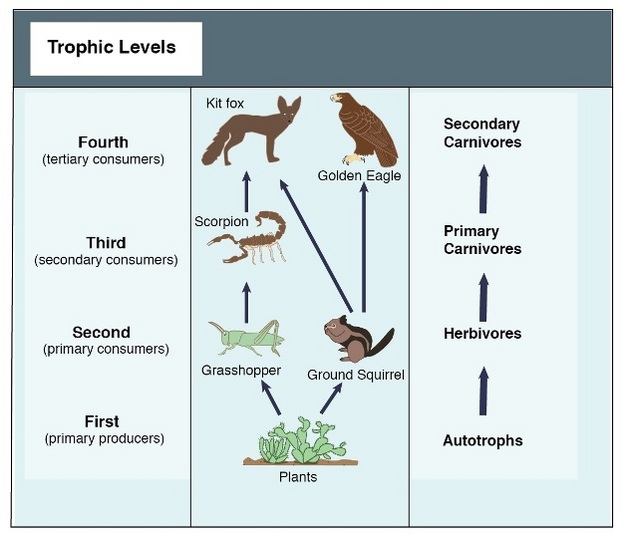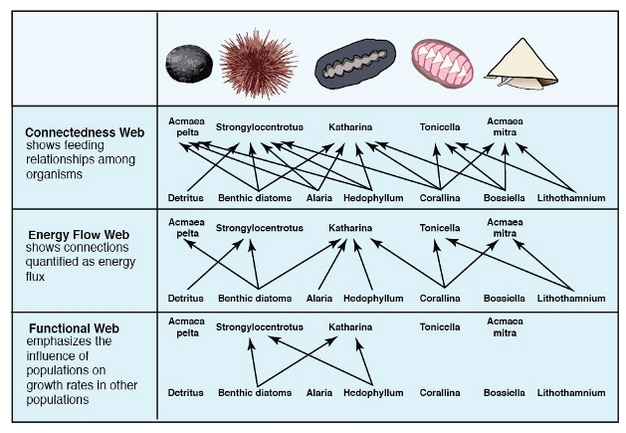![]()
Food web is an important conceptual tool for illustrating the feeding relationships among species within a community, revealing species interactions and community structure, and understanding the dynamics of energy transfer in an ecosystem.
Food web is an important ecological concept. Basically, food web represents feeding relationships within a community (Smith and Smith 2009). It also implies the transfer of food energy from its source in plants through herbivores to carnivores (Krebs 2009). Normally, food webs consist of a number of food chains meshed together. Each food chain is a descriptive diagram including a series of arrows, each pointing from one species to another, representing the flow of food energy from one feeding group of organisms to another.
There are two types of food chains: the grazing food chain, beginning with autotrophs, and the detrital food chain, beginning with dead organic matter (Smith & Smith 2009). In a grazing food chain, energy and nutrients move from plants to the herbivores consuming them, and to the carnivores or omnivores preying upon the herbivores. In a detrital food chain, dead organic matter of plants and animals is broken down by decomposers, e.g., bacteria and fungi, and moves to detritivores and then carnivores.
Food web offers an important tool for investigating the ecological interactions that define energy flows and predator-prey relationship (Cain et al. 2008). Figure 1 shows a simplified food web in a desert ecosystem. In this food web, grasshoppers feed on plants; scorpions prey on grasshoppers; kit foxes prey on scorpions. While the food web showed here is a simple one, most feed webs are complex and involve many species with both strong and weak interactions among them (Pimm et al. 1991). For example, the predators of a scorpion in a desert ecosystem might be a golden eagle, an owl, a roadrunner, or a fox.

![]()
© 2012 Nature Education Adapted from Cain et al. 2008. All rights reserved.
The idea to apply the food chains to ecology and to analyze its consequences was first proposed by Charles Elton (Krebs 2009). In 1927, he recognized that the length of these food chains was mostly limited to 4 or 5 links and the food chains were not isolated, but hooked together into food webs (which he called "food cycles"). The feeding interactions represented by the food web may have profound effects on species richness of community, and ecosystem productivity and stability (Ricklefs 2008).
Food webs describe the relationships — links or connections — among species in an ecosystem, but the relationships vary in their importance to energy flow and dynamics of species populations. Some trophic relationships are more important than others in dictating how energy flows through ecosystems. Some connections are more influential on species population change. Based on different ways in which species influence one another, Robert Paine proposed three types of food webs based on the species of a rocky intertidal zone on the coast of Washington (Ricklefs 2008, Figure 2). Connectedness webs (or topological food webs) emphasize feeding relationships among species, portrayed as links in a food web (Paine 1980). Energy flow webs quantify energy flow from one species to another. Thickness of an arrow reflects the strength of the relationship. Functional webs (or interaction food webs) represent the importance of each species in maintaining the integrity of a community and reflect influence on the growth rate of other species' populations. As shown in Figure 2, limpets Acmaea pelta and A. mitra in the community consume considerable food energy (energy flow web), but removal of these consumers has no detectable influence on the abundance of their resources (functional web). The most effective control was exerted by sea urchin Stronglocentrotus and the chiton Katharina (Ricklefs 2008).

Figure 2: Three types of food web diagrams based on species of a rocky intertidal zone on the coast of Washington.
![]()
© 2012 Nature Education All rights reserved.